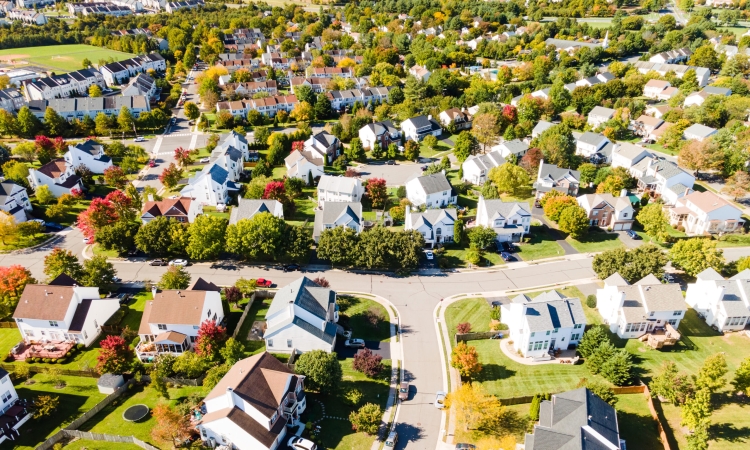Raising a family in U.S. cities is often more expensive than raising one in the suburbs. Substantially higher living costs are due in part to more expensive real estate. Housing in Washington, D.C. is no exception.
This blog combines the best of affordability and family-friendly living, showcasing not only suburbs that are easy on the wallet but also offer close proximity to all the amazing museums, libraries, and historical sites D.C. has to offer.
Save Cash in the Suburbs
D.C. suburbs offer a budget-friendly alternative, with potentially significant 2024 savings on housing (median prices ranging from $300,200 to $424,800) and daycare ($12,000-$15,000 per year), translating to a total estimated savings of $12,832 to $19,000 annually.
If you’re living in the city with a growing family and trying to save some cash, consider relocating to a nearby and less expensive suburban community. Explore the neighborhoods and crunch the numbers of relocating to one of these suburban locales.
1. Woodbridge, Virginia
Woodbridge is situated less than an hour’s drive southwest from the heart of D.C. The city is bordered by the Occoquan River and Occoquan Bay, offering outdoor escapades for the family at the Occoquan Bay National Wildlife Refuge or history lessons at the National Museum of the Marine Corps.
The community is home to the popular Potomac Mills mall, fan-favorite Dixie Bones BBQ, and Pfitzner Stadium — home of the minor league Potomac Nationals.
In April 2024, Woodbridge home prices were up 13.4% compared to last year, selling for a median price of $488K. If this sounds like a fit, check out the available homes in Woodbridge.
2. North Bethesda, Maryland
North Bethesda is just 35 minutes north of downtown D.C., resulting in a much shorter commute than driving in from Woodbridge. If work has you tied to the business district, North Bethesda may be just the burb to grow your family.
You’ll pay more for the proximity – In April 2024, the median listing home price in North Bethesda, MD was $625K, trending up 10.6% year-over-year. – but still less than the price tags in the nation’s capital. Moving to North Bethesda offers luxury movie experiences at iPic Theaters, seasonal American dining at City Perch Kitchen+Bar, and a host of other activities in surrounding Montgomery County. Plus, your kids will get a great education at any of the area schools.
3. Centreville, Virginia
About 40 minutes west of the nation’s capital, you’ll find Centreville, a true suburb with nearby drug stores, a Trader Joe’s for groceries and several small restaurants including hometown staples like Ciao Osteria and Iron Age Korean Steakhouse.
In April 2024, Centreville home prices were up 7.3% compared to last year, selling for a median price of $560K. Take a look at the many of the properties on the market.
4. Reston, Virginia
Reston is a suburb situated about 40 minutes northwest of D.C., and it’s also the first planned community in the nation. The layout includes five highly walkable neighborhoods with one central region, Reston Town Center. The hub offers shopping, restaurants and business high-rises too.
As a local, plan to enjoy the wooded surroundings, several nearby lakes and golfing and tennis just outside your front door.
Home values in Reston reflect its appeal, with a median price of $614,794, up 9.0% over the past year but that’s still about $100,000 cheaper than in the capital.
Whether you are outgrowing your city abode or expecting a larger family soon, take some of the burdens out of your next move. Opt for a lower cost of living with more space in metropolitan D.C., and lean on suburban D.C.’s most trusted moving company to guide your relocation.
5. Ashburn, Virginia
Winding streets and quiet Ashburn neighborhoods create a peaceful vibe. Modern condos and townhouses are common, and the Ashburn Library offers engaging programs for all ages. . Plus, Ashburn’s proximity to D.C. means you can still enjoy all the city’s cultural offerings without the high cost of living.
The median list price of homes in Ashburn, VA was $739,990 in April 2024 , compared to $700,970 in 2023.
6. Leesburg, Virginia
This charming town offers a lower cost of living and a variety of housing options. Parks provide opportunities for outdoor adventures, and the Leesburg Corner Premium Outlets offer great shopping deals. (Cost of Living: 129, compared to D.C. average of 134)
In April 2024, Leesburg home prices were up 28.8% compared to last year, selling for a median price of $760K.
Making the Move
Remember, this is just a starting point! Consider visiting each suburb, talk to residents, and research schools and amenities before making your final decision. By having the numbers and exploring these D.C. suburban options, you can find the perfect place to raise your family and enjoy all the cultural riches the city has to offer, without breaking the bank. Happy house hunting!

Zillow is the leading real estate and rental marketplace dedicated to empowering consumers with data, inspiration, and knowledge around the place they call home and connecting them with the best local professionals who can help.


